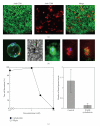Lipid rafts: keys to sperm maturation, fertilization, and early embryogenesis
- PMID: 21490798
- PMCID: PMC3068481
- DOI: 10.1155/2011/264706
Lipid rafts: keys to sperm maturation, fertilization, and early embryogenesis
Abstract
Cell membranes are composed of many different lipids and protein receptors, which are important for regulating intracellular functions and cell signaling. To orchestrate these activities, the cell membrane is compartmentalized into microdomains that are stably or transiently formed. These compartments are called "lipid rafts". In gamete cells that lack gene transcription, distribution of lipids and proteins on these lipid rafts is focused during changes in their structure and functions such as starting flagella movement and membrane fusion. In this paper, we describe the role of lipid rafts in gamete maturation, fertilization, and early embryogenesis.
Figures



References
-
- Brown DA, Rose JK. Sorting of GPI-anchored proteins to glycolipid-enriched membrane subdomains during transport to the apical cell surface. Cell. 1992;68(3):533–544. - PubMed
-
- Tanphaichitr N, Smith J, Mongkolsirikieart S, Gradil C, Lingwood CA. Role of a gamete-specific sulfoglycolipid immobilizing protein on mouse sperm-egg binding. Developmental Biology. 1993;156(1):164–175. - PubMed
-
- Maehashi E, Sato C, Ohta K, et al. Identification of the sea urchin 350-kDa sperm-binding protein as a new sialic acid-binding lectin that belongs to the heat shock protein 110 family: implication of its binding to gangliosides in sperm lipid rafts in fertilization. Journal of Biological Chemistry. 2003;278(43):42050–42057. - PubMed
-
- Toshimori K. Introduction. In: Korf HW, editor. Dynamics of the Mammalian Sperm Head. Vol. 204. New York, NY, USA: Springer; 2009. pp. 5–6. (Advances in Anatomy, Embryology and Cell Biology). - PubMed
LinkOut - more resources
Full Text Sources

